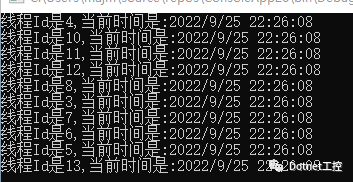概述
Task是微软在.Net 4.0时代推出来的,Task看起来像一个Thread,实际上,它是在ThreadPool的基础上进行的封装,Task的控制和扩展性很强,在线程的延续、阻塞、取消、超时等方面远胜于Thread和ThreadPool,所以一经问世,基本ThreadPool就被取代了。.
Task用法举例
static void Main(string[] args){string str = "当前时间是";for (int i = 0; i < 10; i++){Task.Run(() => ThreadFuc(str));}Console.ReadKey();}public static void ThreadFuc(string str){Console.WriteLine($"线程Id是{Thread.CurrentThread.ManagedThreadId},{str}:{DateTime.Now}");Thread.Sleep(1000);}
运行结果:

这里开了十个线程,task默认就是在线程池中创建线程,他会自行调度和回收不用的线程,减少每次重新创建线程的开销,而且创建的是背景线程。
task有很多封装好的API,比如:
①WaitAll:等待提供的所有 System.Threading.Tasks.Task 对象完成执行过程。
Task.WaitAll(t1,t2);//等待所有任务结束② WaitAny:等待提供的任一 System.Threading.Tasks.Task 对象完成执行过程。
Task.WaitAny(t1,t2);③ContinueWith:创建一个在目标 System.Threading.Tasks.Task 完成时异步执行的延续任务。
实例代码:
static void Main(string[] args){string str = "当前时间是";Task t1 = Task.Run(() => ThreadFuc1(str));Task t2 = Task.Run(() => ThreadFuc2(str));Task.WaitAny(t1,t2);t1.ContinueWith(task =>{Console.WriteLine($"任务完成时的状态:IsCanceled={task.IsCanceled}\tIsCompleted={task.IsCompleted}\tIsFaulted={task.IsFaulted}");});Task.WaitAll(t1,t2);//等待所有任务结束Console.WriteLine($"线程Id是{Thread.CurrentThread.ManagedThreadId},{str}:{DateTime.Now}");Console.ReadKey();}public static void ThreadFuc1(string str){Console.WriteLine($"线程Id是{Thread.CurrentThread.ManagedThreadId},{str}:{DateTime.Now}");Thread.Sleep(1000);}public static void ThreadFuc2(string str){Console.WriteLine($"线程Id是{Thread.CurrentThread.ManagedThreadId},{str}:{DateTime.Now}");Thread.Sleep(2000);}
这里分别开启了两个线程t1、t2,在t1里面等待1秒,t2里面等待2秒,所以执行WaitAny时先等到ti完成,WaitAll时会等到t2完成.最终输出结果如下:

④RunSynchronously:同步启动,对当前的 System.Threading.Tasks.Task 同步运行 System.Threading.Tasks.TaskScheduler。(类似委托开启线程,BeginInvoke是异步,而Invoke是同步)
用法:
Task t1 = new Task(() => ThreadFuc1(str));Task t2 = new Task(() => ThreadFuc2(str));t1.RunSynchronously();t2.RunSynchronously();

⑤Wait:等待 System.Threading.Tasks.Task 完成执行过程。
⑥Start:启动 System.Threading.Tasks.Task,并将它安排到当前的 System.Threading.Tasks.TaskScheduler中执行;
带返回值的使用方式:
static void Main(string[] args){string str = "当前时间是";Task<int> t1 = new Task<int>(() => ThreadFuc1(str));Task<int> t2 = new Task<int>(() => ThreadFuc2(str));t1.Start();t2.Start();Task.WaitAny(t1,t2);t1.ContinueWith(task =>{Console.WriteLine($"任务完成时的状态:IsCanceled={task.IsCanceled}\tIsCompleted={task.IsCompleted}\tIsFaulted={task.IsFaulted}");});Task.WaitAll(t1,t2);//等待所有任务结束int result1 = t2.Result;int result2 = t2.Result;Console.WriteLine($"result1值是{result1},result2值是{result2}");Console.WriteLine($"线程Id是{Thread.CurrentThread.ManagedThreadId},{str}:{DateTime.Now}");Console.ReadKey();}public static int ThreadFuc1(string str){Console.WriteLine($"线程Id是{Thread.CurrentThread.ManagedThreadId},{str}:{DateTime.Now}");Thread.Sleep(1000);return 1;}public static int ThreadFuc2(string str){Console.WriteLine($"线程Id是{Thread.CurrentThread.ManagedThreadId},{str}:{DateTime.Now}");Thread.Sleep(2000);return 2;}
运行结果如下:

